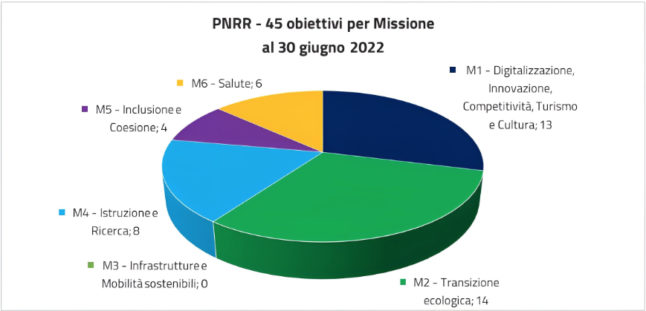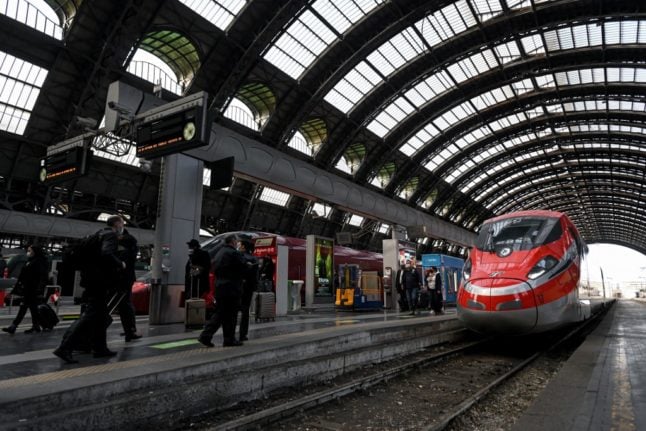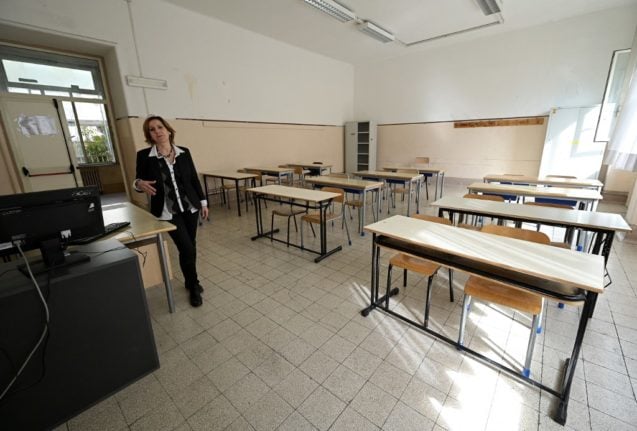EXPLAINED: What’s changing under Italy’s post-pandemic recovery plan?

Italy’s recovery plan is often in the news, but do you know exactly what it involves? With funding for everything from better healthcare to faster wifi, here's what's set to improve about life in the country.
Italy is ready to move on to the next phase of its National Recovery and Resilience Plan (Piano Nazionale di Ripresa e Resilienza, or PNRR), after the government said at the end of June it had met all of its targets for the first half of 2022.
The country is now due to receive its second yearly instalment of funding from the European Commission, amounting to a further 24.1 billion euros. The first payment of 24.9 billion came last August.
But why is Italy receiving this money - and what exactly is the government doing (or planning to do) with it?
Italy is the biggest beneficiary of 750-billion-euro post-pandemic recovery aid package known as the Next Generation EU programme (NGEU), which is being split between member states.
The country is set to receive a total of 191.5 billion euros from the fund by the end of 2026.
In order to access the funding, Italy's government had to set out in the PNRR exactly how it would spend it - on projects that would not only help the national economy recover, but would leave it more resilient in future.
READ ALSO: What does Italy’s latest political crisis mean for the economy?
Prime Minister Mario Draghi, tasked with putting the plan together, said it would help the country recover after being hit particularly hard by the pandemic but that it also “addresses some weaknesses that have plagued our economy and our society for decades”.
The PNRR include plans to upgrade railways, rebuild crumbling roads and bridges, and speed up wifi connections, with the government saying it aims to use the money to improve infrastructure and make Italy a “country for young people”.
The government outlined the ins and outs of all the investments and reforms in the PNRR (with the official document available here), dividing them into six main areas, or 'missions'.

2022’s first semester PNRR objectives divided by category. Photo courtesy of Italia Domani, Piano Nazionale di Ripresa e Resilienza.
The gradual completion of the plan is expected to bring about a yearly 0.5-percent GDP increase.
Here’s a closer look at some the most relevant investments and reforms included in the plan.
Digitalisation, innovation, competitiveness, culture and tourism
Over 40 billion euros will be poured into the ‘digitalisation and innovation’ measures.
Simplifying and streamlining public administration procedures will be one of the government’s top priorities as the planned measures will try to reduce the time of civil and criminal trials by 40 and 25 percent respectively.
Other interventions will revolve around the installation of 5G nationwide and the construction of high-speed internet networks covering government agencies, schools, health facilities and museums all across the country.
Also, ultra-fast broadband is expected to serve an additional 8.5 million families by 2026.
OPINION: Italy has a big chance to improve internet speeds – but will it take it?
A number of measures are aimed at enhancing Italy’s immense cultural heritage by improving access to historical sites located in rural or remote areas (as part of a Piano Nazionale Borghi, or National Plan for Villages), and by digitalising services connected with the tourism industry.
As part of the tourism redevelopment project, Rome will receive around 500 million euros which will be used to enhance 283 of its historical sites.

Construction of high-speed rail on the Naples-Bari line is expected to reduce the journey time by as much as 90 minutes. Photo by Piero CRUCIATTI / AFP
Green revolution and ecological transition
Funds adding up to a total of 59.5 billion euros (equal to 31 percent of the Recovery Plan’s total value) will be injected into the ‘green revolution’ mission.
Much of the ecological transition plan will revolve around the development of renewable energy solutions, including agrovoltaic plants and hydrogen charging stations for road vehicles.
There are also plans to modernise current waste management facilities and build new ones to achieve a “circular economy” (a model of consumption based on the ‘use, recycle and reuse’ principle).
Finally, electricity grids will be upgraded all over the country and water leakages are expected to decrease by as much as 15 percent by 2026 due to system improvements.
Infrastructure for sustainable mobility
Over 13 percent (25.4 billion euros) of the funds will be set aside for the improvement of Italy’s transport network.
The major measures will involve the construction of high-speed rail on the following lines in southern Italy: Salerno-Reggio Calabria, Naples-Bari and Palermo-Catania, with journey times dropping by as much as 90 minutes.
Regional and local railway lines and stations will also be upgraded to make public transport more accessible to all.
The planned improvements also include the renovation of many bridges, tunnels and viaducts across the country amid longstanding concerns about safety and stability.

As many as 40,000 Italian schools will be equipped with high-speed internet connection in a bid to offer pupils the latest learning methods. Photo by Vincenzo PINTO / AFP
Education and research
The Italian education system will undergo major changes as part of a dedicated 31-billion-euro package.
The available funds will be used to renovate 2.4 million square metres of school buildings and create 228,000 new places in nurseries.
Also, as many as 40,000 institutes will be equipped with high-speed internet connection to allow for the implementation of innovative learning methods.
In closing, student accommodation will go from the current 40,000 available lodgings to 100,000 by the end of 2026.
Cohesion and inclusion
The ‘cohesion and inclusion’ mission, which has been allocated a total of 19.9 billion euros, seeks to build a brighter future for the next generations by innovating the labour market, erasing social and economic inequalities and supporting female entrepreneurship.
A number of nationwide programmes, including the new Worker Employability Guarantee, will aim to increase the national employment rate and provide key assistance for unemployed individuals.
Other than that, a Women’s Entrepreneurship Fund will be set up to support female-run businesses and increase gender equality in the labour market.
Finally, the plan states that the government will work to reduce marginalisation by redeveloping public areas, promoting local cultural activities and offering support for people with disabilities.
Healthcare
The Italian healthcare system will receive PNRR funds amounting to a total of 15.6 billion euros.
The government’s priority will be to improve hospital infrastructure by modernising existing structures and building new ones – 400 community hospitals for short-term medical care and 1,350 care homes will be built by 2026.
Additionally, intensive care units will be upgraded and hospitals across the country will receive state-of-the-art appliances for CAT scans, MRIs and other medical tests.
Comments
See Also
Italy is ready to move on to the next phase of its National Recovery and Resilience Plan (Piano Nazionale di Ripresa e Resilienza, or PNRR), after the government said at the end of June it had met all of its targets for the first half of 2022.
The country is now due to receive its second yearly instalment of funding from the European Commission, amounting to a further 24.1 billion euros. The first payment of 24.9 billion came last August.
But why is Italy receiving this money - and what exactly is the government doing (or planning to do) with it?
Italy is the biggest beneficiary of 750-billion-euro post-pandemic recovery aid package known as the Next Generation EU programme (NGEU), which is being split between member states.
The country is set to receive a total of 191.5 billion euros from the fund by the end of 2026.
In order to access the funding, Italy's government had to set out in the PNRR exactly how it would spend it - on projects that would not only help the national economy recover, but would leave it more resilient in future.
READ ALSO: What does Italy’s latest political crisis mean for the economy?
Prime Minister Mario Draghi, tasked with putting the plan together, said it would help the country recover after being hit particularly hard by the pandemic but that it also “addresses some weaknesses that have plagued our economy and our society for decades”.
The PNRR include plans to upgrade railways, rebuild crumbling roads and bridges, and speed up wifi connections, with the government saying it aims to use the money to improve infrastructure and make Italy a “country for young people”.
The government outlined the ins and outs of all the investments and reforms in the PNRR (with the official document available here), dividing them into six main areas, or 'missions'.

The gradual completion of the plan is expected to bring about a yearly 0.5-percent GDP increase.
Here’s a closer look at some the most relevant investments and reforms included in the plan.
Digitalisation, innovation, competitiveness, culture and tourism
Over 40 billion euros will be poured into the ‘digitalisation and innovation’ measures.
Simplifying and streamlining public administration procedures will be one of the government’s top priorities as the planned measures will try to reduce the time of civil and criminal trials by 40 and 25 percent respectively.
Other interventions will revolve around the installation of 5G nationwide and the construction of high-speed internet networks covering government agencies, schools, health facilities and museums all across the country.
Also, ultra-fast broadband is expected to serve an additional 8.5 million families by 2026.
OPINION: Italy has a big chance to improve internet speeds – but will it take it?
A number of measures are aimed at enhancing Italy’s immense cultural heritage by improving access to historical sites located in rural or remote areas (as part of a Piano Nazionale Borghi, or National Plan for Villages), and by digitalising services connected with the tourism industry.
As part of the tourism redevelopment project, Rome will receive around 500 million euros which will be used to enhance 283 of its historical sites.

Green revolution and ecological transition
Funds adding up to a total of 59.5 billion euros (equal to 31 percent of the Recovery Plan’s total value) will be injected into the ‘green revolution’ mission.
Much of the ecological transition plan will revolve around the development of renewable energy solutions, including agrovoltaic plants and hydrogen charging stations for road vehicles.
There are also plans to modernise current waste management facilities and build new ones to achieve a “circular economy” (a model of consumption based on the ‘use, recycle and reuse’ principle).
Finally, electricity grids will be upgraded all over the country and water leakages are expected to decrease by as much as 15 percent by 2026 due to system improvements.
Infrastructure for sustainable mobility
Over 13 percent (25.4 billion euros) of the funds will be set aside for the improvement of Italy’s transport network.
The major measures will involve the construction of high-speed rail on the following lines in southern Italy: Salerno-Reggio Calabria, Naples-Bari and Palermo-Catania, with journey times dropping by as much as 90 minutes.
Regional and local railway lines and stations will also be upgraded to make public transport more accessible to all.
The planned improvements also include the renovation of many bridges, tunnels and viaducts across the country amid longstanding concerns about safety and stability.

Education and research
The Italian education system will undergo major changes as part of a dedicated 31-billion-euro package.
The available funds will be used to renovate 2.4 million square metres of school buildings and create 228,000 new places in nurseries.
Also, as many as 40,000 institutes will be equipped with high-speed internet connection to allow for the implementation of innovative learning methods.
In closing, student accommodation will go from the current 40,000 available lodgings to 100,000 by the end of 2026.
Cohesion and inclusion
The ‘cohesion and inclusion’ mission, which has been allocated a total of 19.9 billion euros, seeks to build a brighter future for the next generations by innovating the labour market, erasing social and economic inequalities and supporting female entrepreneurship.
A number of nationwide programmes, including the new Worker Employability Guarantee, will aim to increase the national employment rate and provide key assistance for unemployed individuals.
Other than that, a Women’s Entrepreneurship Fund will be set up to support female-run businesses and increase gender equality in the labour market.
Finally, the plan states that the government will work to reduce marginalisation by redeveloping public areas, promoting local cultural activities and offering support for people with disabilities.
Healthcare
The Italian healthcare system will receive PNRR funds amounting to a total of 15.6 billion euros.
The government’s priority will be to improve hospital infrastructure by modernising existing structures and building new ones – 400 community hospitals for short-term medical care and 1,350 care homes will be built by 2026.
Additionally, intensive care units will be upgraded and hospitals across the country will receive state-of-the-art appliances for CAT scans, MRIs and other medical tests.
Join the conversation in our comments section below. Share your own views and experience and if you have a question or suggestion for our journalists then email us at [email protected].
Please keep comments civil, constructive and on topic – and make sure to read our terms of use before getting involved.
Please log in here to leave a comment.